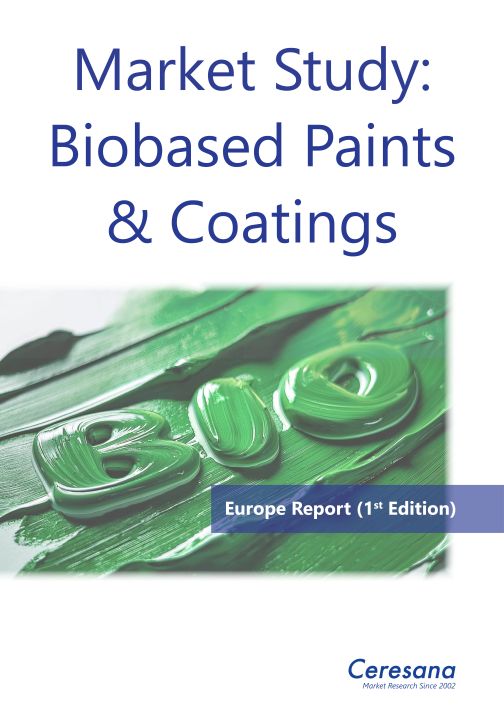Back to the roots? Natural dyes have long been displaced in the construction industry by acrylic, vinyl, and other plastic paints. However, renewable raw materials are now being rediscovered as part of the bioeconomy and circular economy. So far, these organic paints only make up a small part of the overall demand for paints and coatings. However, their sales are increasing significantly: The new Ceresana market study “Bio-Based Paints and Coatings – Europe” forecasts that European demand for these products will increase to around EUR 6.6 billion over the next ten years. In addition to market data and forecasts on bio-based coatings, the market report also contains background information on the regulatory framework of the paints and coatings industry in Europe as well as the general economic situation and the situation in the construction industry (including important companies, construction activities, investments) in the individual countries.
Bio-Based Paints for Facades and Walls
For the first time, Ceresana has specifically analyzed the European bio-based paints and bio-based coatings market, including products used for interior and exterior building applications or as industrial and wood coatings. These “green” coatings are sold under various names: Natural paints, organic paints, eco paints, or even vegan paints. They are made entirely or at least partially from natural raw materials or minerals. The exact meaning of “bio-based” is defined differently by various certification bodies and eco-labels such as the German “Blue Angel”, the Austrian “Umweltzeichen”, or the “Nordic Swan”. Ideally, the raw materials should come from sustainable agriculture, forestry, or fisheries and remain as unaltered as possible. The main components of bio-based paints, i.e. pigments, binders, solvents, and fillers, can be obtained from plant starch, tree resins, mussel shells, or chicken feathers, among other things. This not only reduces dependence on crude oil and natural gas, but also allows previously unused biomass waste to be utilized.
Healthy and Environmentally Friendly Paints
Although organic coatings are not yet suitable for all applications and are often more expensive than petrochemical paints, they promise to be healthier and more environmentally friendly. In addition, they can be combined well with other sustainable building materials, for example with bio-based insulating materials, bio-based adhesives, and bioplastics. Some bio-based paints and coatings offer better quality and economy than their fossil-based competitors, such as higher color stability, abrasion resistance, viscosity, or color coverage. Natural pigments offer a very broad color spectrum. Diffusion-open natural paints prevent condensation and mold: They allow moisture in the air to pass through, can store it and release it again. Above all, however, organic coatings are largely free of toxic additives – and are therefore also suitable for sensitive areas such as children’s rooms. The “full declaration” of all ingredients not only helps people suffering from allergies and people with chemical intolerances. The long-term effects of solvents, plasticizers, nanoparticles, and other potentially toxic paint substances often still need to be researched. In contrast, many natural materials have been known and tried and tested for centuries, such as lime paints. Last but not least, biodegradable paint residues do not have to be disposed of as hazardous waste at great expense.
The Current European Market Report “Bio-Based Paints and Coatings”:
Chapter 1 of the new biobased paints and coatings market study provides a comprehensive presentation and analysis of the European market for bio-based paints and coatings – with forecasts up to 2034. The development of demand (in tonnes) and revenues (in USD and EUR) is included in the analysis. These areas of application are being investigated: construction, industry, transportation, wood processing, and other applications. In Chapter 2, the largest national markets for bio-based paints and coatings in Europe are examined individually, i.e. 16 countries: The bio-based paints and coatings market size is analyzed in the form of demand and revenues for the various applications. Chapter 3 provides useful company profiles of the most important European bio-based paints and coatings manufacturers, clearly arranged according to contact details, financial figures such as revenues and net income, product range, production sites, and profile summary. Detailed profiles of 33 manufacturers are supplied, e.g. DAW SE, BASF SE, Akzo Nobel N.V., IVM S.r.l., Beckers Group, Tikkurila Oyj, and Renner Italia S.P.A. Further information on the market study “Bio-Based Paints and Coatings – Europe Report” (1st edition): https://ceresana.com/en/produkt/biobased-paints-and-coatings-market-report-europe

About Ceresana
As one of the world’s leading market research institutes, Ceresana specializes in the packaging, plastics, chemicals, and industrial goods sectors. One particular focus is the bio-economy: Ceresana has been supporting the dynamically growing circular economy for more than a decade with market analyses and forecasts on bio-based products and biodegradable materials. More than 250 market studies provide more than 10,000 customers around the world with the knowledge base for their sustainable success. With the digital event series “Future of Bio”, Ceresana is creating a platform for experts and specialists to exchange knowledge, utilize synergies, and jointly drive the future of the bio-economy forward. Learn more about Ceresana at www.ceresana.com
Let’s meet! The new Ceresana event series on the future of the bio-economy continues. The online event “Future of BioPackaging” will take place on October 28 and 29, 2025: https://ceresana.com/en/events/future-of-biopackaging
Ceresana
Mainaustrasse 34
78464 Konstanz
Germany
Press Contact: Martin Ebner, m.ebner@ceresana.com
